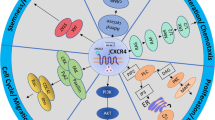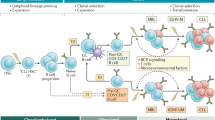Abstract
MYD88 (myeloid differentiation primary response 88) is mutated in the majority of Waldenström macroglobulinemia/lymphoplasmacytic lymphoma (LPL); but also, albeit less frequently, in other B-cell malignancies, including chronic lymphocytic leukemia (CLL). This suggests MYD88 as a central regulator of pathogenesis, but requests a broader approach to define diagnostically relevant genetic profiles for LPL and CLL. We identified the L265P hotspot mutation in 86% (n=67/78) of our LPL and 2% (n=12/767) of our CLL cohort. Importantly, in CLL (n=5), but also in LPL (n=4) other MYD88 mutations were identified. MYD88-mutated LPL was characterized by CXCR4 mutations (25%) and del(6q) (19%), whereas both aberrations were absent in the MYD88-unmutated LPL cases. MYD88-mutated CLL formed a prognostically favorable subset with a high frequency of del(13q), mutated IGHV status and no adverse aberrations (del(11q), del(17p), TP53 mutations). MYD88-mutated CLL differed from LPL with respect to cytogenetic aberrations and the absence of CXCR4 mutations. In both entities, based on mutation load evaluation, MYD88 mutations were found to be present in the stem clone in each case, whereas CXCR4 (LPL) and SF3B1 (CLL) mutations also occurred in subclones only.
This is a preview of subscription content, access via your institution
Access options
Subscribe to this journal
Receive 12 print issues and online access
$259.00 per year
only $21.58 per issue
Buy this article
- Purchase on Springer Link
- Instant access to full article PDF
Prices may be subject to local taxes which are calculated during checkout






Similar content being viewed by others
References
Ngo VN, Young RM, Schmitz R, Jhavar S, Xiao W, Lim KH et al. Oncogenically active MYD88 mutations in human lymphoma. Nature 2011; 470: 115–119.
Puente XS, Pinyol M, Quesada V, Conde L, Ordonez GR, Villamor N et al. Whole-genome sequencing identifies recurrent mutations in chronic lymphocytic leukaemia. Nature 2011; 475: 101–105.
Treon SP, Xu L, Yang G, Zhou Y, Liu X, Cao Y et al. MYD88 L265P somatic mutation in Waldenstrom's macroglobulinemia. N Engl J Med 2012; 367: 826–833.
Yang G, Zhou Y, Liu X, Xu L, Cao Y, Manning RJ et al. A mutation in MYD88 (L265P) supports the survival of lymphoplasmacytic cells by activation of Bruton tyrosine kinase in Waldenstrom macroglobulinemia. Blood 2013; 122: 1222–1232.
Swerdlow SH, Campo E, Pileri SA, Harris NL, Stein H, Siebert R et al. The 2016 revision of the World Health Organization (WHO) classification of lymphoid neoplasms. Blood 2016; 127: 2375–2390.
Xu L, Hunter ZR, Yang G, Zhou Y, Cao Y, Liu X et al. MYD88 L265P in Waldenstrom macroglobulinemia, immunoglobulin M monoclonal gammopathy, and other B-cell lymphoproliferative disorders using conventional and quantitative allele-specific polymerase chain reaction. Blood 2013; 121: 2051–2058.
Jimenez C, Sebastian E, Chillon MC, Giraldo P, Hernandez JM, Escalante F et al. MYD88 L265P is a marker highly characteristic of, but not restricted to, Waldenstrom's macroglobulinemia. Leukemia 2013; 27: 1722–1728.
Varettoni M, Zibellini S, Arcaini L, Boveri E, Rattotti S, Pascutto C et al. MYD88 (L265P) mutation is an independent risk factor for progression in patients with IgM monoclonal gammopathy of undetermined significance. Blood 2013; 122: 2284–2285.
Gachard N, Parrens M, Soubeyran I, Petit B, Marfak A, Rizzo D et al. IGHV gene features and MYD88 L265P mutation separate the three marginal zone lymphoma entities and Waldenstrom macroglobulinemia/lymphoplasmacytic lymphomas. Leukemia 2013; 27: 183–189.
Martinez-Trillos A, Pinyol M, Navarro A, Aymerich M, Jares P, Juan M et al. Mutations in the Toll-like receptor/MYD88 pathway in chronic lymphocytic leukemia identify a subset of young patients with favorable outcome. Blood 2014; 123: 3790.
Baliakas P, Hadzidimitriou A, Agathangelidis A, Rossi D, Sutton LA, Kminkova J et al. Prognostic relevance of MYD88 mutations in CLL: the jury is still out. Blood 2015; 126: 1043–1044.
Braggio E, Philipsborn C, Novak A, Hodge L, Ansell S, Fonseca R . Molecular pathogenesis of Waldenstrom’s macroglobulinemia. Haematologica 2012; 97: 1281–1290.
Haferlach C, Dicker F, Schnittger S, Kern W, Haferlach T . Comprehensive genetic characterization of CLL: a study on 506 cases analysed with chromosome banding analysis, interphase FISH, IgV(H) status and immunophenotyping. Leukemia 2007; 21: 2442–2451.
Quesada V, Ramsay AJ, Rodriguez D, Puente XS, Campo E, Lopez-Otin C . The genomic landscape of chronic lymphocytic leukemia: clinical implications. BMC Med 2013; 11: 124.
Hunter ZR, Xu L, Yang G, Zhou Y, Liu X, Cao Y et al. The genomic landscape of Waldenstrom macroglobulinemia is characterized by highly recurring MYD88 and WHIM-like CXCR4 mutations, and small somatic deletions associated with B-cell lymphomagenesis. Blood 2014; 123: 1637–1646.
Roccaro AM, Sacco A, Jimenez C, Maiso P, Moschetta M, Mishima Y et al. C1013G/CXCR4 acts as a driver mutation of tumor progression and modulator of drug resistance in lymphoplasmacytic lymphoma. Blood 2014; 123: 4120–4131.
Xu L, Hunter ZR, Tsakmaklis N, Cao Y, Yang G, Chen J et al. Clonal architecture of CXCR4 WHIM-like mutations in Waldenstrom macroglobulinaemia. Br J Haematol 2016; 172: 735–744.
Treon SP, Cao Y, Xu L, Yang G, Liu X, Hunter ZR . Somatic mutations in MYD88 and CXCR4 are determinants of clinical presentation and overall survival in Waldenstrom macroglobulinemia. Blood 2014; 123: 2791–2796.
Poulain S, Roumier C, Venet-Caillault A, Figeac M, Herbaux C, Marot G et al. Genomic landscape of CXCR4 mutations in Waldenstrom macroglobulinemia. Clin Cancer Res 2016; 22: 1480–1488.
Nagao T, Oshikawa G, Ishida S, Akiyama H, Umezawa Y, Nogami A et al. A novel MYD88 mutation, L265RPP, in Waldenstrom macroglobulinemia activates the NF-kappaB pathway to upregulate Bcl-xL expression and enhances cell survival. Blood Cancer J 2015; 5: e314.
Treon SP, Xu L, Hunter Z . MYD88 mutations and response to ibrutinib in Waldenstrom's macroglobulinemia. N Engl J Med 2015; 373: 584–586.
Jeromin S, Weissmann S, Haferlach C, Dicker F, Bayer K, Grossmann V et al. SF3B1 mutations correlated to cytogenetics and mutations in NOTCH1, FBXW7, MYD88, XPO1 and TP53 in 1160 untreated CLL patients. Leukemia 2014; 28: 108–117.
Kern W, Dicker F, Schnittger S, Haferlach C, Haferlach T . Correlation of flow cytometrically determined expression of ZAP-70 using the SBZAP antibody with IgVH mutation status and cytogenetics in 1,229 patients with chronic lymphocytic leukemia. Cytometry B Clin Cytom 2009; 76: 385–393.
Kern W, Bacher U, Haferlach C, Dicker F, Alpermann T, Schnittger S et al. Monoclonal B-cell lymphocytosis is closely related to chronic lymphocytic leukaemia and may be better classified as early-stage CLL. Br J Haematol 2012; 157: 86–96.
Kern W, Bacher U, Haferlach C, Alpermann T, Dicker F, Schnittger S et al. Frequency and prognostic impact of the aberrant CD8 expression in 5,523 patients with chronic lymphocytic leukemia. Cytometry B Clin Cytom 2012; 82: 145–150.
Hunter ZR, Branagan AR, Manning R, Patterson CJ, Santos DD, Tournilhac O et al. CD5, CD10, and CD23 expression in Waldenstrom's macroglobulinemia. Clin Lymphoma 2005; 5: 246–249.
Löffler H, Rastetter J, Haferlach T . Atlas of Clinical Hematology. 6th edn Springer: Heidelberg, Germany, 2010.
Weber S, Alpermann T, Dicker F, Jeromin S, Nadarajah N, Eder C et al. BAALC expression: a suitable marker for prognostic risk stratification and detection of residual disease in cytogenetically normal acute myeloid leukemia. Blood Cancer J 2014; 4: e173.
Grossmann V, Haferlach C, Weissmann S, Roller A, Schindela S, Poetzinger F et al. The molecular profile of adult T-cell acute lymphoblastic leukemia: mutations in RUNX1 and DNMT3A are associated with poor prognosis in T-ALL. Genes Chromosomes Cancer 2013; 52: 410–422.
Dicker F, Schnittger S, Haferlach T, Kern W, Schoch C . Immunostimulatory oligonucleotide-induced metaphase cytogenetics detect chromosomal aberrations in 80% of CLL patients: a study of 132 CLL cases with correlation to FISH, IgVH status, and CD38 expression. Blood 2006; 108: 3152–3160.
Schoch C, Schnittger S, Bursch S, Gerstner D, Hochhaus A, Berger U et al. Comparison of chromosome banding analysis, interphase- and hypermetaphase-FISH, qualitative and quantitative PCR for diagnosis and for follow-up in chronic myeloid leukemia: a study on 350 cases. Leukemia 2002; 16: 53–59.
Haferlach C, Bacher U . Cytogenetic methods in chronic lymphocytic leukemia. Method Mol Biol 2011; 730: 119–130.
Shaffer LG, McGowan-Jordan J, Schmid M (eds). ISCN 2013: An International System for Human Cytogenetic Nomenclature. Karger: Basel, Switzerland: 2013.
Bonzheim I, Giese S, Deuter C, Susskind D, Zierhut M, Waizel M et al. High frequency of MYD88 mutations in vitreoretinal B-cell lymphoma: a valuable tool to improve diagnostic yield of vitreous aspirates. Blood 2015; 126: 76–79.
Wang JQ, Jeelall YS, Beutler B, Horikawa K, Goodnow CC . Consequences of the recurrent MYD88(L265P) somatic mutation for B cell tolerance. J Exp Med 2014; 211: 413–426.
Landau DA, Tausch E, Taylor-Weiner AN, Stewart C, Reiter JG, Bahlo J et al. Mutations driving CLL and their evolution in progression and relapse. Nature 2015; 526: 525–530.
Landau DA, Carter SL, Stojanov P, McKenna A, Stevenson K, Lawrence MS et al. Evolution and impact of subclonal mutations in chronic lymphocytic leukemia. Cell 2013; 152: 714–726.
Gustine J, Meid K, Xu L, Hunter ZR, Castillo JJ, Treon SP . To select or not to select? The role of B-cell selection in determining the MYD88 mutation status in Waldenstrom Macroglobulinaemia. Br J Haematol, e-pub ahead of print 2 March 2016 doi:10.1111/bjh.13996.
Treon SP, Hunter ZR . A new era for Waldenstrom macroglobulinemia: MYD88 L265P. Blood 2013; 121: 4434–4436.
Xu L, Hunter ZR, Yang G, Cao Y, Liu X, Manning R et al. Detection of MYD88 L265P in peripheral blood of patients with Waldenstrom's Macroglobulinemia and IgM monoclonal gammopathy of undetermined significance. Leukemia 2014; 28: 1698–1704.
Poulain S, Boyle EM, Roumier C, Demarquette H, Wemeau M, Geffroy S et al. MYD88 L265P mutation contributes to the diagnosis of Bing Neel syndrome. Br J Haematol 2014; 167: 506–513.
Schmidt J, Federmann B, Schindler N, Steinhilber J, Bonzheim I, Fend F et al. MYD88 L265P and CXCR4 mutations in lymphoplasmacytic lymphoma identify cases with high disease activity. Br J Haematol 2015; 169: 795–803.
Grossmann V, Roller A, Klein HU, Weissmann S, Kern W, Haferlach C et al. Robustness of amplicon deep sequencing underlines its utility in clinical applications. J Mol Diagn 2013; 15: 473–484.
Rose D, Alpermann T, Haferlach C, Haferlach T, Kern W . Excess coincidences of hematopoietic neoplasms. Blood 2016; 126: 2688a.
Kim JA, Im K, Park SN, Kwon J, Choi Q, Hwang SM et al. MYD88 L265P mutations are correlated with 6q deletion in Korean patients with Waldenstrom macroglobulinemia. Biomed Res Int 2014; 2014: 363540.
Poulain S, Roumier C, Galiegue-Zouitina S, Daudignon A, Herbaux C, Aiijou R et al. Genome wide SNP array identified multiple mechanisms of genetic changes in Waldenstrom macroglobulinemia. Am J Hematol 2013; 88: 948–954.
Liu X, Hunter ZR, Xu L, Chen J, Chen JG, Tsakmaklis N et al. Targeting myddosome assembly in Waldenstrom macroglobulinaemia. Br J Haematol, e-pub ahead of print 13 April 2016 doi:1111/bjh.14103.
Treon SP, Tripsas CK, Meid K, Warren D, Varma G, Green R et al. Ibrutinib in previously treated Waldenstrom's macroglobulinemia. N Engl J Med 2015; 372: 1430–1440.
Cao Y, Hunter ZR, Liu X, Xu L, Yang G, Chen J et al. The WHIM-like CXCR4(S338X) somatic mutation activates AKT and ERK, and promotes resistance to ibrutinib and other agents used in the treatment of Waldenstrom's Macroglobulinemia. Leukemia 2015; 29: 169–176.
Cao Y, Yang G, Hunter ZR, Liu X, Xu L, Chen J et al. The BCL2 antagonist ABT-199 triggers apoptosis, and augments ibrutinib and idelalisib mediated cytotoxicity in CXCR4 Wild-type and CXCR4 WHIM mutated Waldenstrom macroglobulinaemia cells. Br J Haematol 2015; 170: 134–138.
Author information
Authors and Affiliations
Corresponding author
Ethics declarations
Competing interests
CB, FD: employment by MLL Munich Leukemia Laboratory; WK, TH, CH: equity ownership of MLL Munich Leukemia Laboratory
Rights and permissions
About this article
Cite this article
Baer, C., Dicker, F., Kern, W. et al. Genetic characterization of MYD88-mutated lymphoplasmacytic lymphoma in comparison with MYD88-mutated chronic lymphocytic leukemia. Leukemia 31, 1355–1362 (2017). https://doi.org/10.1038/leu.2016.330
Received:
Revised:
Accepted:
Published:
Issue Date:
DOI: https://doi.org/10.1038/leu.2016.330
This article is cited by
-
Lymphoplasmacytic lymphoma and a CD5+ lymphoproliferative process presenting as composite disease in the bone marrow: a report of two cases
Journal of Hematopathology (2021)
-
Clinicopathological characterization of chronic lymphocytic leukemia with MYD88 mutations: L265P and non-L265P mutations are associated with different features
Blood Cancer Journal (2020)



